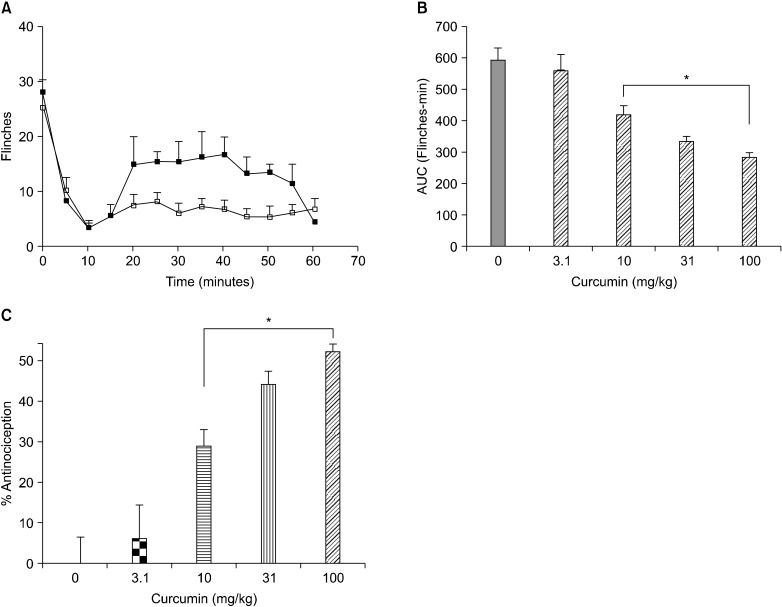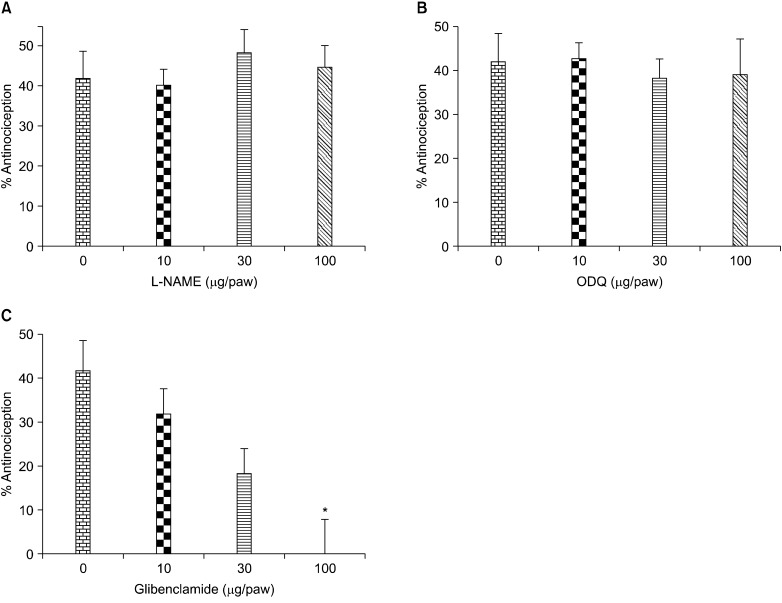Korean J Pain.
2012 Oct;25(4):221-227. 10.3344/kjp.2012.25.4.221.
Evidence for the Participation of ATP-sensitive Potassium Channels in the Antinociceptive Effect of Curcumin
- Affiliations
-
- 1Department of Pharmacology, Center for Research and Advanced Studies of the National Polytechnic Institute, Mexico, DF, Mexico. gcastane@cinvestav.mx
- 2Laboratory of Pharmacology, Institutional Program in Molecular Biomedicine, National School of Medicine and Homeopathy, National Polytechnic Institute, Mexico, DF, Mexico.
- 3Academic Area of Medicine and Health Sciences, Autonomous University of the State of Hidalgo, Pachuca, Hidalgo, Mexico.
- KMID: 2278162
- DOI: http://doi.org/10.3344/kjp.2012.25.4.221
Abstract
- BACKGROUND
It has been reported that curcumin, the main active compound of Curcuma longa, also known as turmeric, exhibits antinociceptive properties. The aim of this study was to examine the participation of ATP-sensitive potassium channels (KATP channels) and, in particular, that of the L-arginine-nitric oxide-cyclic GMP-KATP channel pathway, in the antinociceptive effect of curcumin.
METHODS
Pain was induced by the intraplantar injection of 1% formalin in the right hind paw of Wistar rats. Formalin-induced flinching behavior was interpreted as an expression of nociception. The antinociceptive effect of oral curcumin was explored in the presence and absence of local pretreatment with L-NAME, an inhibitor of nitric oxide synthase, ODQ, an inhibitor of soluble guanylyl cyclase, and glibenclamide, a blocker of KATP channels.
RESULTS
Oral curcumin produced a dose-dependent antinociceptive effect in the 1% formalin test. Curcumin-induced antinociception was not altered by local L-NAME or ODQ, but was significantly impaired by glibenclamide.
CONCLUSIONS
Our results confirm that curcumin is an effective antinociceptive agent. Curcumin-induced antinociception appears to involve the participation of KATP channels at the peripheral level, as local injection of glibenclamide prevented its effect. Activation of KATP channels, however, does not occur by activation of the L-arginine-nitric oxide-cGMP-KATP channel pathway.
Keyword
MeSH Terms
-
Curcuma
Curcumin
Formaldehyde
Glyburide
Guanylate Cyclase
KATP Channels
NG-Nitroarginine Methyl Ester
Nitric Oxide Synthase
Nociception
Pain Measurement
Potassium Channels
Rats, Wistar
Receptors, Cytoplasmic and Nuclear
Curcumin
Formaldehyde
Glyburide
Guanylate Cyclase
KATP Channels
NG-Nitroarginine Methyl Ester
Nitric Oxide Synthase
Potassium Channels
Receptors, Cytoplasmic and Nuclear
Figure
Reference
-
1. Rivera-Espinoza Y, Muriel P. Pharmacological actions of curcumin in liver diseases or damage. Liver Int. 2009; 29:1457–1466. PMID: 19811613.
Article2. Basnet P, Skalko-Basnet N. Curcumin: an anti-inflammatory molecule from a curry spice on the path to cancer treatment. Molecules. 2011; 16:4567–4598. PMID: 21642934.
Article3. Goel A, Kunnumakkara AB, Aggarwal BB. Curcumin as "Curecumin": from kitchen to clinic. Biochem Pharmacol. 2008; 75:787–809. PMID: 17900536.
Article4. Aggarwal BB, Sung B. Pharmacological basis for the role of curcumin in chronic diseases: an age-old spice with modern targets. Trends Pharmacol Sci. 2009; 30:85–94. PMID: 19110321.
Article5. Chainani-Wu N. Safety and anti-inflammatory activity of curcumin: a component of tumeric (Curcuma longa). J Altern Complement Med. 2003; 9:161–168. PMID: 12676044.
Article6. Burgos-Morón E, Calderón-Montaño JM, Salvador J, Robles A, López-Lázaro M. The dark side of curcumin. Int J Cancer. 2010; 126:1771–1775. PMID: 19830693.
Article7. Kapoor S. Curcumin and its emerging role in pain modulation and pain management. Korean J Pain. 2012; 25:202–203. PMID: 22787555.
Article8. Agarwal KA, Tripathi CD, Agarwal BB, Saluja S. Efficacy of turmeric (curcumin) in pain and postoperative fatigue after laparoscopic cholecystectomy: a double-blind, randomized placebo-controlled study. Surg Endosc. 2011; 25:3805–3810. PMID: 21671126.
Article9. Sharma S, Kulkarni SK, Agrewala JN, Chopra K. Curcumin attenuates thermal hyperalgesia in a diabetic mouse model of neuropathic pain. Eur J Pharmacol. 2006; 536:256–261. PMID: 16584726.
Article10. Zhao X, Xu Y, Zhao Q, Chen CR, Liu AM, Huang ZL. Curcumin exerts antinociceptive effects in a mouse model of neuropathic pain: descending monoamine system and opioid receptors are differentially involved. Neuropharmacology. 2012; 62:843–854. PMID: 21945716.
Article11. Tajik H, Tamaddonfard E, Hamzeh-Gooshchi N. The effect of curcumin (active substance of turmeric) on the acetic acid-induced visceral nociception in rats. Pak J Biol Sci. 2008; 11:312–314. PMID: 18817212.
Article12. Yeon KY, Kim SA, Kim YH, Lee MK, Ahn DK, Kim HJ, et al. Curcumin produces an antihyperalgesic effect via antagonism of TRPV1. J Dent Res. 2010; 89:170–174. PMID: 20040737.
Article13. Mittal N, Joshi R, Hota D, Chakrabarti A. Evaluation of antihyperalgesic effect of curcumin on formalin-induced orofacial pain in rat. Phytother Res. 2009; 23:507–512. PMID: 19051211.
Article14. Leamy AW, Shukla P, McAlexander MA, Carr MJ, Ghatta S. Curcumin ((E,E)-1,7-bis(4-hydroxy-3-methoxyphenyl)-1,6-heptadiene-3,5-dione) activates and desensitizes the nociceptor ion channel TRPA1. Neurosci Lett. 2011; 503:157–162. PMID: 21855605.
Article15. Du X, Wang C, Zhang H. Activation of ATP-sensitive potassium channels antagonize nociceptive behavior and hyperexcitability of DRG neurons from rats. Mol Pain. 2011; 7:35. PMID: 21569593.
Article16. Lázaro-Ibáñez GG, Torres-López JE, Granados-Soto V. Participation of the nitric oxide-cyclic GMP-ATP-sensitive K(+) channel pathway in the antinociceptive action of ketorolac. Eur J Pharmacol. 2001; 426:39–44. PMID: 11525769.
Article17. Ortiz MI, Granados-Soto V, Castañeda-Hernández G. The NO-cGMP-K+ channel pathway participates in the antinociceptive effect of diclofenac, but not of indomethacin. Pharmacol Biochem Behav. 2003; 76:187–195. PMID: 13679232.
Article18. León-Reyes MR, Castañeda-Hernández G, Ortiz MI. Pharmacokinetics and pharmacodynamics of diclofenac in the presence and absence of glibenclamide in the rat. J Pharm Pharm Sci. 2008; 11:68–76.
Article19. Ocaña M, Del Pozo E, Barrios M, Robles LI, Baeyens JM. An ATP-dependent potassium channel blocker antagonizes morphine analgesia. Eur J Pharmacol. 1990; 186:377–378. PMID: 2127024.
Article20. Ocaña M, Baeyens JM. Differential effects of K+ channel blockers on antinociception induced by alpha 2-adrenoceptor, GABAB and kappa-opioid receptor agonists. Br J Pharmacol. 1993; 110:1049–1054. PMID: 7905339.
Article21. Robles LI, Barrios M, Del Pozo E, Dordal A, Baeyens JM. Effects of K+ channel blockers and openers on antinociception induced by agonists of 5-HT1A receptors. Eur J Pharmacol. 1996; 295:181–188. PMID: 8720582.
Article22. Kweon TD, Kim JY, Kwon IW, Choi JB, Lee YW. Participation of K(ATP) channels in the antinociceptive effect of pregabalin in rat formalin test. Korean J Pain. 2011; 24:131–136. PMID: 21935490.
Article23. Soares AC, Leite R, Tatsuo MA, Duarte ID. Activation of ATP-sensitive K(+) channels: mechanism of peripheral antinociceptive action of the nitric oxide donor, sodium nitroprusside. Eur J Pharmacol. 2000; 400:67–71. PMID: 10913586.
Article24. White RE, Lee AB, Shcherbatko AD, Lincoln TM, Schonbrunn A, Armstrong DL. Potassium channel stimulation by natriuretic peptides through cGMP-dependent dephosphorylation. Nature. 1993; 361:263–266. PMID: 7678699.
Article25. Ocaña M, Barrios M, Baeyens JM. Cromakalim differentially enhances antinociception induced by agonists of alpha(2)-adrenoceptors, gamma-aminobutyric acid(B), mu and kappa opioid receptors. J Pharmacol Exp Ther. 1996; 276:1136–1142. PMID: 8786544.26. Zimmermann M. Ethical guidelines for investigations of experimental pain in conscious animals. Pain. 1983; 16:109–110. PMID: 6877845.
Article27. Jeong HJ, Lee SH, Cho SY, Lee CS, Jeong CW, Yoon MH, et al. Roles of serotonergic and adrenergic receptors in the antinociception of selective cyclooxygenase-2 inhibitor in the rat spinal cord. Korean J Pain. 2011; 24:179–184. PMID: 22220238.
Article28. Ortiz MI, Lozano-Cuenca J, Granados-Soto V, Castañeda-Hernández G. Additive interaction between peripheral and central mechanisms involved in the antinociceptive effect of diclofenac in the formalin test in rats. Pharmacol Biochem Behav. 2008; 91:32–37. PMID: 18602417.
Article29. Lozano-Cuenca J, Castañeda-Hernández G, Granados-Soto V. Peripheral and spinal mechanisms of antinociceptive action of lumiracoxib. Eur J Pharmacol. 2005; 513:81–91. PMID: 15878712.
Article30. Ortiz MI, Ramírez-Montiel ML, González-García MP, Ponce-Monter HA, Castañeda-Hernández G, Cariño-Cortés R. The combination of naproxen and citral reduces nociception and gastric damage in rats. Arch Pharm Res. 2010; 33:1691–1697. PMID: 21052946.
Article31. Jiménez-Andrade JM, Ortiz MI, Pérez-Urizar J, Aguirre-Bañuelos P, Granados-Soto V, Castañeda-Hernández G. Synergistic effects between codeine and diclofenac after local, spinal and systemic administration. Pharmacol Biochem Behav. 2003; 76:463–471. PMID: 14643845.
Article32. Gil-Flores M, Ortiz MI, Castañeda-Hernández G, Chávez-Piña AE. Acemetacin antinociceptive mechanism is not related to NO or K+ channel pathways. Methods Find Exp Clin Pharmacol. 2010; 32:101–105. PMID: 20401346.
Article33. Ocaña M, Cendán CM, Cobos EJ, Entrena JM, Baeyens JM. Potassium channels and pain: present realities and future opportunities. Eur J Pharmacol. 2004; 500:203–219. PMID: 15464034.
Article34. Alves DP, Soares AC, Francischi JN, Castro MS, Perez AC, Duarte ID. Additive antinociceptive effect of the combination of diazoxide, an activator of ATP-sensitive K+ channels, and sodium nitroprusside and dibutyryl-cGMP. Eur J Pharmacol. 2004; 489:59–65. PMID: 15063156.
Article35. Soares AC, Duarte ID. Dibutyryl-cyclic GMP induces peripheral antinociception via activation of ATP-sensitive K(+) channels in the rat PGE2-induced hyperalgesic paw. Br J Pharmacol. 2001; 134:127–131. PMID: 11522604.
Article36. Distrutti E, Sediari L, Mencarelli A, Renga B, Orlandi S, Antonelli E, et al. Evidence that hydrogen sulfide exerts antinociceptive effects in the gastrointestinal tract by activating KATP channels. J Pharmacol Exp Ther. 2006; 316:325–335. PMID: 16192316.
Article
- Full Text Links
- Actions
-
Cited
- CITED
-
- Close
- Share
- Similar articles
-
- Effect of Intracellular ATP on Zn2+ Blockade of KATP Channels in Pancreatic Beta Cells
- Activation of the Cardiac ATP-Sensitive K+Channel by KR-30816,Newly Synthesized Potassium Channel Opener
- Characteristics of Potassium Channel in the Isolated Rat Detrusor Muscle
- The Role of Mitochondrial ATP-sensitive Potassium Channel on Intestinal Pacemaking Activity
- Effects of micron-Opioid Agonist on ATP-sensitive Potassium Channel Activity in Isolated Ventricular Cardiomyocytes



